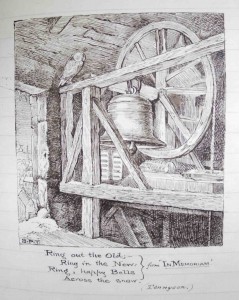It’s lovely to work with the Rowntree Society on an event they are organising for York Residents’ Festival this weekend (25th to 26th January 2014). There will be lots of Rowntree activities for all ages including finding out how quickly you can pack a box of chocolates! The Rowntree family were closely linked to Bootham School, and you can find out more about Quaker education in the exhibition. The event is in the Recital Room (entrance through 45 Bootham) and is open from 10am until 4pm on Saturday 25th and Sunday 26th January. Check the Rowntree Society website for more details.
Christmas Bells
Term has finished, with all the Christmas events the end of term brings, this year’s ‘Bootham’ magazine has just been posted, and the school is quiet. From my office I can hear the Minster clock chime. So it seems appropriate to end this Christmas series with a drawing of ‘The Christmas Bells’ from the ‘Extra Christmas Number’ of The Observer from 1873.
The editor finishes his introduction to the issue by “wishing Contributors, Artists, Poets and Readers
A Merry Christmas and a Happy New Year
20 Bootham, December 11th 1873”
140 years later, I would like to send the same wishes to everyone reading this.
- The Observer, Vol XII, p735. The image is signed SPT, almost certainly Silvanus Philips Thompson, who was a pupil at Bootham School between 1858 and 1867, and taught at the school between 1870 and 1875. He went on to become a well known physicist and there is a blue plaque with his name on Bootham.
- 20 Bootham was later renumbered as 51 Bootham.
The Robin
“Is not the robin always brought with pleasant recollections to our minds when we think about the legend of the little children who lost themselves in the wood, I think I am justified in saying that he is.”
So Bernard B. Alexander starts his essay about robins in the 1866 edition of The Observer. Thanks to Jenny Bailey, the past Head of English and Senior Mistress, for identifying the legend as ‘Babes in the Wood’, where a robin covers the two children with leaves.
After the brief reference to legend, Bernard’s essay goes on to describe the robin in enormous detail, including their behaviour, where they live and so on. There is more than a page about their “pugnacity”, and Bernard talks about experiments that he’d heard of involving a robin’s reaction to a toy robin in the window.
Natural History has a strong tradition at Bootham, and the Natural History Society was established in 1834. The essays in The Observer, the Natural History Journal (which was made up of contributions from all the Quaker schools in England and Ireland) and the other records of the society show that an enormous amount of time, energy and care went into observing and recording the world around them.
Notes:
- Vol. VII, p153-65. The essay was written by Bernard B. Alexander, who was at Bootham School between 1862 and 1866.
- For more on Bootham School’s Natural History Society, see http://www.boothamschool.com/senior-school/about-bootham/school-history/natural-history-society/ or the book Natural History at Bootham: the early years (contact me if you would like more details).
Skating and Sliding
I’ve thought for a while that one of the marks of being ‘grown up’ is whether or not you get excited by snow. Last winter I had to concede that I might be grown up, as I checked the forecasts, got very cold scraping ice off the car, and worried about slipping over.
As the season for cold weather arrives again, it seems appropriate to start a series of extracts from the Observer with illustrations and words from ‘Skating and Sliding’, from November 1865, in which John W. Procter describes what happened when the weather got cold enough.
“The first time that we had occasion to put on our skates this year, occurred about the 20th of Jan, when we had sufficient frost to make it worthwhile ‘pouring down’ for skating and sliding.
Accordingly leave was applied for by some of our most energetic and skilful companions and being kindly granted the asphalt was covered for skating and a slide was made from the fives court down to the bottom of the playground, out of which we had a good deal of pleasure as well as many rolls and tumbles.
We also had some pleasant skating, though the primary foundation of the skating ground being composed of asphalt instead of water which necessarily made it rather rough and as there are always a great many performers, and not too much space to perform in, before very long it got worn through in some places and stones and other ‘tripups’ appeared in abundance, which of course, caused further skating not to be salutary either with respect to ourselves or our skates.”
Notes:
- The Observer features handwritten essays by Bootham students on a wide range of subjects. It ran from 1856 to 1963, and many of the essays include beautiful illustrations.
- The essay is in Vol VI, Number 18, 1865, p329-340. The author was John W. Procter, who was at Bootham between 1862 and 1866. According to the 1935 Bootham School Register, he went on to become an agricultural merchant and chemical manure manufacturer.
- The essay goes on to talk about how they looked for other places to skate. They were not allowed by skate at the new skating ground at Heworth, which was owned by the skating club, but were able to skate at Strensall Common.
- The essay includes a cautionary tale about the dangers of skating on frozen ponds, thankfully apparently no one was seriously injured or killed. I should point out that the passage should be read with a ‘don’t try this at home (or in the playground)’ warning!




